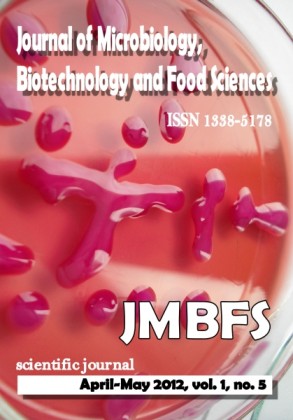POLYSACCHARIDES PRODUCTION FROM SOME PSEUDOMONAS SYRINGAE PATHOVARS AS AFFECTED BY DIFFERENT TYPES OF CULTURE MEDIA
Keywords:
Exopolysaccharides, Pseudomonas syringae pathovars, alginateAbstract
Exopolysaccharides (EPS) produced from Pseudomonas syringae pv. tomato, P. syringae Davson 973 and P. syringae pv. coriandricola 908 were studied as affected by different types of culture media. The I.R. spectroscopy data of purified polysaccharides from these organisms were compared with authentic algal alginate sample. The results show presence of many functional groups in the obtained EPS which are: H- bonded hydroxyl group typical for polysaccharide (1050- 1100 and 3200-3600 nm) as well as C-H (at 1380-1450 cm and 2930 cm). The presence of bands at 2000-2800 nm region indicated the presence of free carboxyl groups. The spectrum showed a band at 948.5 nm, which assign to the C–O stretching vibration of uronic acid residues, and one at 888.3 nm assigned to the C1–H deformation vibration of β-mannuronic acid residues and also a band at 820.0 nm was detected. The obtained results indicate that purified EPSs from the tested organisms have great similarity with the authentic algal alginate sample. Thus, EPSs produced by P. syringae pv. tomato, P. syringae Davson 973 and P. syringae pv. coriandricola 908 could be identified as alginate.Downloads
Download data is not yet available.
Downloads
Published
2012-04-01
How to Cite
El-Anwar Osman, M., El-Shouny, W., Talat, R., & El-Zahaby, H. (2012). POLYSACCHARIDES PRODUCTION FROM SOME PSEUDOMONAS SYRINGAE PATHOVARS AS AFFECTED BY DIFFERENT TYPES OF CULTURE MEDIA. Journal of Microbiology, Biotechnology and Food Sciences, 1(5), 1305–1318. Retrieved from https://office2.jmbfs.org/index.php/JMBFS/article/view/7238
Issue
Section
Microbiology
License
Copyright (c) 2012 Mohammed El-Anwar Osman, Wagih El-Shouny, Ragdah Talat, Heba El-Zahaby

This work is licensed under a Creative Commons Attribution 4.0 International License.
All papers published in the Journal of Microbiology, Biotechnology and Food Sciences are published under a CC-BY licence (CC-BY 4.0). Published materials can be shared (copy and redistribute the material in any medium or format) and adapted (remix, transform, and build upon the material for any purpose, even commercially) with specifying the author(s).

